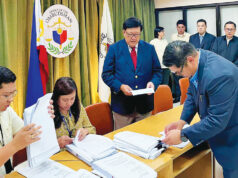
THE overall year-on-year increase in prices of widely used goods quickened slightly in July, the fastest in six months, the Philippine Statistics Authority (PSA) reported on Wednesday.
Preliminary data from the PSA showed headline inflation at 2.7% last month, picking up from the 2.5% pace in June and the 2.4% rate in July 2019.
The July figure was a tad higher than the 2.6% median in a BusinessWorld poll conducted late last week and fell within the 2.2%-3% estimate given by the Bangko Sentral ng Pilipinas (BSP) for that month.
Year to date, inflation settled at 2.5%, still within the BSP’s 2%-4% target band and above the 2.3% forecast for the entire 2020.
Core inflation, which discounted volatile prices of food and fuel, stood at 3.3% in July, accelerating from 3% the previous month and 3.2% logged last year.
Food-alone inflation eased to 2.5% from 2.7% the previous month, but faster than 1.7% a year ago.
The PSA attributed the July result mostly to the transport index, which recorded a faster inflation rate of 6.3% during the month from 2.4% in June.
The PSA also noted annual increments in the following commodity groups: alcoholic beverages and tobacco (19.3% from 18.5% in June); housing, water, electricity, gas and other fuels (0.8% from 0.3%); restaurant and miscellaneous goods and services (2.5% from 2.3%).
Moreover, the PSA reported preliminary figures for inflation as experienced by low-income households for July. With heavier weights on essentials such as food, the inflation rate for the bottom 30% of income households was 2.9%, slower than June’s three percent, but faster than July 2019’s 2.5%.
“The July 2020 [headline] inflation of 2.7% was within the BSP’s forecast range of 2.2-3.0%. The latest inflation outturn is consistent with the BSP’s prevailing assessment that inflation is expected to remain benign over the policy horizon due largely to the potential adverse impact of COVID-19 on the domestic and global economic prospects,” BSP Governor Benjamin E. Diokno said in a Viber message to reporters.
Mr. Diokno said inflation is likely to settle close to the midpoint of the government’s 2-4% target range for 2020 to 2022, adding the Monetary Board (MB) will consider the latest inflation outlook along with the release of second-quarter gross domestic product (GDP) data today (Aug. 6) when it meets on Aug. 20 to discuss monetary policy.
In a note, HSBC Global economist Noelan Arbis said inflation “remains largely contained” in the country, but noted a “few interesting surprises.”
“Transport costs continued to rise at an above-trend pace sequentially, despite global oil prices remaining relatively steady compared to the previous month. This might be a result of higher demand for transportation services, as the economy emerged out of lockdown. Other discretionary line items, such as restaurants and miscellaneous goods and services, also saw above-trend price increases perhaps due to the economy re-opening,” Mr. Arbis said, who noted these are more likely one-off price increases.
“We expect inflation to remain below midpoint of the BSP’s 2-4% target range for the remainder of the year,” he added.
OUTLOOK
“With moderate inflation, the BSP is likely to focus more closely on growth in its policy rate decisions in the months ahead,” HSBC’s Mr. Arbis said.
“All things considered, we expect the BSP to cut the policy rate by another 25 basis points (bps) to 2.00% by year-end, likely in [the fourth quarter]. Moreover, we forecast an additional 200-bp cut in the RRR (reserve requirement ratio) by year-end to provide another boost to domestic liquidity. This would bring the RRR down to 10% by year-end,” he added.
The BSP has so far shaved rates by a total of 175 bps this year, with the latest easing round in June. This brought the overnight reverse repurchase, lending, and deposit rates to record lows of 2.25%, 2.75%, and 1.75%, respectively.
The central bank has likewise cut the RRR of universal and commercial lenders by 200 bps in April to 12% to boost liquidity in the midst of the lockdown. The RRR for thrift and rural banks were also cut by 100 bps in July to three percent and two percent, respectively, to support increased lending for small businesses amid the crisis.
The MB is authorized to cut up to 400 bps of lenders’ reserve requirement this year to support banks’ lending capacity during the crisis.
For ING Bank N.V. Manila Senior Economist Nicholas Antonio T. Mapa, the slight uptick in inflation for July “may be enough” for the central bank to keep rates on hold at their next policy meeting.
“The BSP Governor [Diokno] previously indicated he would keep his stance unchanged ‘for at least two quarters’ and we believe he will refrain from cutting policy rates further to prevent real policy rates from falling too deep into negative territory,” Mr. Mapa said in an e-mail.
“BSP… has also shared that it will take the [second-quarter] GDP report into account for future policy decisions, but we only expect BSP to alter its stance should growth fall well past the most pessimistic GDP forecast for [the second quarter],” Mr. Mapa added.
For Security Bank Chief Economist Robert Dan J. Roces: “The latest print increases the probability that the BSP will again refrain from cutting its policy rate as real interest rates now at -0.45%. This expectation of steady rates will provide further support to the peso, although we have yet to see [the second-quarter] GDP numbers,” he said in a separate e-mail.
In a statement, the National Economic and Development Authority (NEDA) called for the national and local governments to bolster risk management systems to ensure sufficient supply and delivery of essentials that will support a stable inflation for the country.
“Although we expect that the overall consumer prices will remain benign until 2021, we recognize that the upside risks to the inflation outlook still remain,” Acting Socioeconomic Planning Secretary Karl Kendrick Chua was quoted in the NEDA statement as saying.
“We need to remain vigilant and ensure that strategies are well-placed to ensure stable supply and delivery of essential commodities in all parts of the country,” he added. — Lourdes O. Pilar



